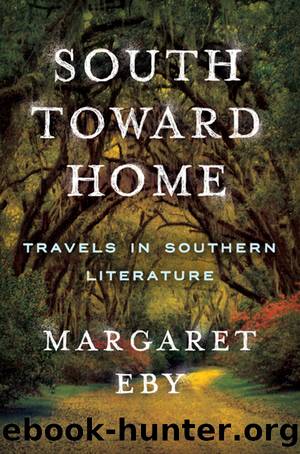South Toward Home by Margaret Eby

Author:Margaret Eby
Language: eng
Format: epub
Publisher: W. W. Norton & Company
THE CENTERPIECE OF To Kill a Mockingbird is the lone architectural landmark of Monroeville: the county courthouse. The courthouse square sits at the center of town and is really the only way that you would know that you had entered Monroeville. The opening pages of Mockingbird describe Monroevilleâs downtown, loosely disguised as the hamlet of Maycomb, as it was in the 1930s:
In rainy weather the streets grew to red slop; grass grew on the sidewalks, the courthouse sagged in the square . . . bony mules hitched to Hoover carts flicked flies in the sweltering shade of the live oaks on the square. Menâs stiff collars wilted by nine in the morning. Ladies bathed before noon, after their three-oâclock naps, and by nightfall were like soft teacakes with frostings of sweat and talcum.
By the time Mockingbird came out, the court square had lost some of the leaky-molasses pace that Lee described in her book. Gone were the mules, and even the live oaks. When art director Henry Bumstead, tasked with adapting the quiet town of Maycomb to the screen for the film version of Mockingbird, came to Monroeville in 1962, his crew found the square too modernized to use for their exterior shots. No mules, no Hoover carts. (They ended up re-creating much of Monroeville on a back lot in Hollywood, including a painstaking replica of the inside of the courthouse.)
Today, the square is the liveliest place in town. Monroeville remains, as Lee wrote about Maycomb, âan island in a patchwork sea of cotton fields and timberland,â a government town in the countryside of southwest Alabama prevented from much growth by its location far away from the closest ports. Around the courthouse, a perimeter of faded brick buildings keep guard. Chipped, faded signs advertise long out-of-business dry-goods companies, but the occupants of the buildings are mostly banks, county offices, and boutiques specializing in monogrammed canvas totes and college football teamâthemed hair ribbons. The corner hardware store, now out of business, was once the townâs all-purpose shopping stop; couples would register for their weddings there. Outside the store stood large birdhouses painted with references to Mockingbird and the square; nearby is Radleyâs Fountain Grill, named after Leeâs fictional shut-in, Boo, and the Maycomb Mall. The offices of Barnett, Bugg, Lee & Carter, where Harper Leeâs father, Amasa Coleman Lee, and sister Alice Finch Lee both practiced, is a block away.
The museum itself is a small one, mostly run by volunteers. Three years after the publication of Mockingbird, county employees moved out of the building and into the offices scattered around the square. In 1968, still riding the wave of Leeâs publication fame, the courthouse reopened as a local attraction.
The first floor has the gift shop and a small exhibit about the history of Monroeville, which began, like so many Alabama towns, as an agricultural crossroads for exporters of timber and cotton. One room is devoted to a re-creation of a country lawyerâs office, a nod to Leeâs description of the nook
Download
This site does not store any files on its server. We only index and link to content provided by other sites. Please contact the content providers to delete copyright contents if any and email us, we'll remove relevant links or contents immediately.
America Is in the Heart by Carlos Bulosan(504)
Frederick Douglass : Autobiographies : Narrative of the Life of Frederick Douglass, an American Slave My Bondage and My Freedom Life and Times of Frederick Douglass (Library of America) by Frederick Douglass(473)
Cuando era puertorriqueña by Esmeralda Santiago(432)
Narrative of The Life of Frederick Douglass[Illustrated] by Frederick Douglass(430)
Tecumseh and the Prophet by Peter Cozzens(405)
The Last American Hero by Unknown(379)
Down South by Bruce Ansley(377)
Dark Dreams by Roy Hazelwood(370)
Race by unknow(353)
The Complete Autobiographies of Frederick Douglass by Frederick Douglass(350)
Breathe by Imani Perry(332)
The Mission; or Scenes in Africa by Frederick Marryat(327)
Taipei (Vintage Contemporaries) by Tao Lin(319)
Mo'ne Davis by Mo'ne Davis(317)
Black Dove by Ana Castillo(307)
In the Shadow of the Valley: A Memoir by Bobi Conn(286)
Of Color by Jaswinder Bolina(279)
A Daughter of the Middle Border by Hamlin Garland(274)
From Deptford to Antarctica by Wilkinson Pete(268)
